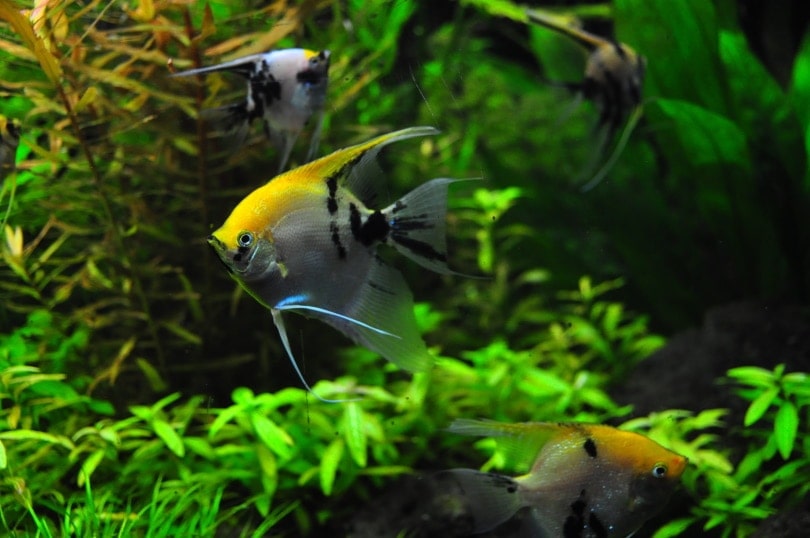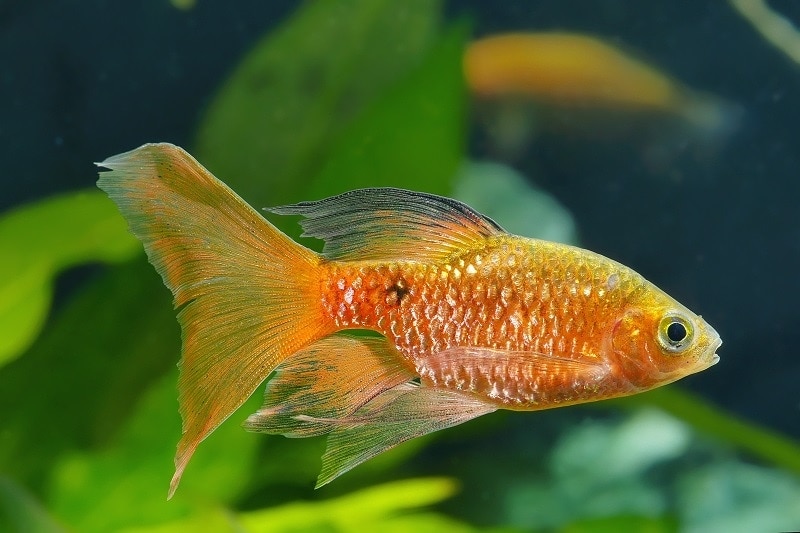10 Great Tank Mates for Clown Loach (With Pictures)

Updated on

Click to Skip Ahead
The Clown Loach is an attractive addition to any tank with sufficient space to accommodate the growth of this fish. It’s peaceful on all scores, although it won’t turn down a potential meal of a species. It’s also a hardy animal that can handle the challenges of less-than-ideal conditions. While beginners may have some success, it’s a fish that is better suited to experienced enthusiasts.
The 10 Great Tank Mates for Clown Loach
1. Green Terror Cichlid (Andinoacara rivulatus)

| Size | Up to 12” L |
| Diet | Carnivore |
| Minimum tank size | 30 gallons |
| Care Level | Medium |
| Temperament | Semi-aggressive |
The Green Terror, like many cichlids, comes with a tough-sounding name. This South American fish prefers the same water conditions as the Clown Loach. They are both larger species, which reduces the risk of one eating the other. The Green Terror sticks to its own kind for the most part. It will dig the substrate, which is something to bear in mind if you want live plants in your aquarium.
2. Angelfish (Pterophyllum scalare)

| Size | 8–10 inches |
| Diet | Carnivore |
| Minimum tank size | 30 gallons |
| Care Level | Moderate |
| Temperament | Peaceful |
The Angelfish is a fitting addition to a tank with Clown Loaches because it has that same exotic look that makes these fish so interesting. It is a docile species that gets along with most other tankmates. The two fishes probably wouldn’t interact a lot since the Angelfish takes it slow, whereas the Clown Loach is a fast-moving tankmate.
3. Pearl Gourami (Trichopodus leerii)

| Size | Up to 5” L |
| Diet | Omnivore |
| Minimum tank size | 30 gallons |
| Care Level | Moderate |
| Temperament | Semi-aggressive |
The Pearl Gourami gets its name from the iridescent spots on its flanks. Like bettas, the species is a labyrinth fish that can breathe atmospheric oxygen. They fare best in small schools where they will hang out together and leave their tankmates alone. They come from a similar climate as Clown Loaches, and, thus, are used to the same living conditions.
4. Forktail Rainbowfish (Pseudomugil furcatus)
| Size | Up to 2” L |
| Diet | Omnivore |
| Minimum tank size | 30 gallons |
| Care Level | Easy |
| Temperament | Peaceful |
The Forktail Rainbowfish is a striking addition to any tank. This one is gorgeous, with yellow fins on its silver-colored body. They are a schooling fish, which do best with some like tankmates. They are also hardy and easy to care for, which is another excellent point in their favor. Since they are smaller, it’s wise to add plants and hiding places for them to take cover if needed.
5. Discus (Symphysodon discus)

| Size | 6–10 inches |
| Diet | Carnivore |
| Minimum tank size | 50 gallons |
| Care Level | High |
| Temperament | Peaceful |
The Discus makes an excellent tankmate because it’s such a peaceful fish. It isn’t fussy and keeps to itself. It makes its presence known by its decent shape and size. You know that this fish is there. This species fares best in a larger tank, which gives it the extra space it needs to avoid conflict. The Discus is a special-needs species, which works well with the Clown Loach.
6. Tinfoil Barb (Barbonymus schwanenfeldii)

| Size | Up to 12” L |
| Diet | Omnivore |
| Minimum tank size | 55 gallons |
| Care Level | Easy |
| Temperament | Social |
The Tinfoil Barb is appropriately named, with its shiny silver color. It prefers the fast-moving water that the Clown Loach enjoys. That descriptor also defines its activity level. The Tinfoil Barb is often seen darting around the tank or even jumping if given a chance. They are relatively long-lived and hardy fish, making them a good choice for beginners.
7. Diamond Tetra (Moenkhausia pittieri)

| Size | Up to 2.5” L |
| Diet | Omnivore |
| Minimum tank size | 15 gallons |
| Care Level | Easy |
| Temperament | Peaceful |
The Diamond Tetra is an active fish that will do well in large tanks. Like others of its kind, it is a schooling fish and quite hardy. The coloration of this species is stunning, with a curious spot of red on the top of its eye. An aquarium well-stocked with a variety of plants occupying all levels is an ideal setting for this fish. They aren’t picky eaters and will enjoy the same foods you offer your Clown Loach.
8. Rosy Barb (Pethia conchonius)

| Size | Up to 6” |
| Diet | Omnivore |
| Minimum tank size | 20 gallons |
| Care Level | Easy |
| Temperament | Peaceful |
The Rosy Barb is another active fish that lives in the same conditions as the Clown Loach in the wild. It is an attractive species that will add some welcome color to your tank. They do best in small skills, which will also give them some protection from larger species in the aquarium. They are tolerant of less than ideal conditions. Rosy Barbs feed on a variety of foods and may eat live plants.
9. Zebra Loach (Botia striata)

| Size | Up to 4” |
| Diet | Omnivore |
| Minimum tank size | 30 gallons |
| Care Level | Easy |
| Temperament | Easygoing |
It’s hard not to notice the colorful Zebra Loach, with the vertical stripes that give it its name. They make excellent beginner fish because they are so easygoing when kept in small schools. While they get along fine with the Clown Loach, they may bump heads with other bottom-dwelling fish. They do best in tanks with plenty of cover.
10. Redtail Rasbora (Rasbora borapetensis)
| Size | Up to 2” |
| Diet | Carnivore |
| Minimum tank size | 20 gallons |
| Care Level | Moderate |
| Temperament | Peaceful |
The Redtail Rasbora is a hardy fish that is worth adding to your tank if just for its looks. It’s an attractive species that is relatively easygoing. It’ll get along with almost any other fish, as long as you have several members so that they can school together. It’ll eat the same things that you give your Clown Loach, making its care easier.
What Makes a Good Tank Mate for Clown Loach?
Peaceful is the operative word. The Clown Loach won’t hassle other tankmates. Therefore, this species does best with fish that are of a similar mindset. It’s a serene existence that doesn’t step on the fins of other fish. This loach is active, so long-finned fish are not an option. They’ll likely get nipped with their lack of speed.
Where Do Clown Loach Prefer to Live in the Aquarium?
The Clown Loach hangs out in the lower areas of the tank. It’ll do well with other fish that can respect its space. This species isn’t demanding and won’t encroach on the space of others in the tank. However, it’s best to go with a larger aquarium if just because of its larger potential size. Bear in mind that it also likes its space and hiding places.

Water Parameters
The origins of Clown Loach are the tropical waters of South America. They prefer warmer temperatures that are typical of their environment. Acidity levels in the soft acidic to neutral ranges are best for these fish. They usually inhabit moving water in their native habitat in rivers and other fast-moving water bodies. That makes optimal conditions something to keep on your radar with them.
Size
The Clown Loach can reach a decent size if given the right conditions. It can get up to 12 inches if it has the space to grow. The larger it gets, the smaller the pool of potential tankmates. Smaller fish are simply just bait unless they live in schools for protection. The Clown Loach eat anything that doesn’t eat them first. That doesn’t mean that they are aggressive. It’s just survival of the fittest at work.
Aggressive Behaviors
The Clown Loach isn’t especially aggressive. However, it does like its space. It’ll do best with schooling fish that will prefer their own company and leave this guy alone. The loach is active, so chasing is a part of its behavior. It almost seems like it’s a game for them. It’s a reflection of the fact that their typical habitat is faster-moving waters that may encourage this behavior.

The 4 Benefits of Having Tank Mates for Clown Loach in Your Aquarium
1. The Clown Loach Lives a Long Time
Clown Loaches can tolerate less than ideal conditions. That makes them an excellent choice for beginners who are still learning the ropes about aquarium management.
2. Clown Loaches Are an Attractive Fish
While it’s not a beauty contest, we are often drawn to fish that stand out because of their attractive colors. The Clown Loach is no exception. It’s an eye-catching species that will capture your attention with its striping pattern and contrasting colors.
3. Clown Loaches Make It Interesting
Some fish are boring, simply because they don’t move around a lot or are not interactive. Nothing can be further from the truth with Clown Loaches. You know they are in your tank. They spend their days, darting around chasing each other or just for fun.
4. Clown Loaches Are Cute
Okay, we’ll admit that calling fish cute is a bit of a stretch. However, it’s hard to ignore with the Clown Loach. Maybe it’s the pattern of colors or their body structures. We just look at them and think they are somehow cuddly.
Conclusion
The Clown Loach does best in a community tank where it can live in the company of other species. It’s essential to keep it with other species of its size or schooling fish in an aquarium with cover. Many of its potential tankmates are jumpers, so a well-fitting cover is a must-have. The Clown Loach also does best in warmer waters with faster-moving water. Overall, they are fascinating fish you’re sure to enjoy.
- Read More: 10 Best Tank Mates for Yoyo Loaches
Featured Image Credit: Joan Carles Juarez, Shutterstock













